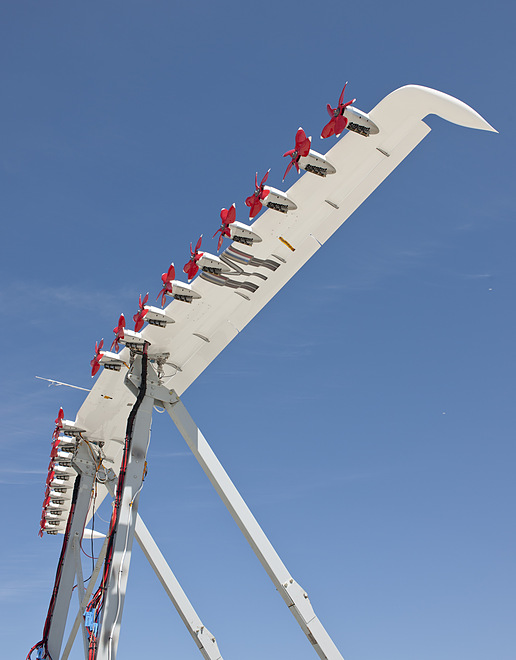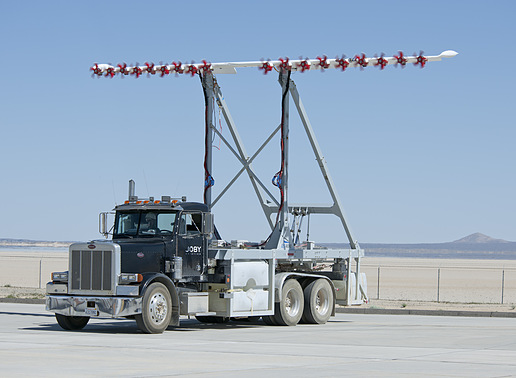 NASA正在使用LEAPtech吹气机翼来评估飞机的均布式电动推进器。
NASA正在使用LEAPtech吹气机翼来评估飞机的均布式电动推进器。 NASA计划将Tecnam轻型飞机的机翼和发动机替换成改良后的成排推进器吹气机翼。
NASA计划将Tecnam轻型飞机的机翼和发动机替换成改良后的成排推进器吹气机翼。 NASA混合动力与电动综合系统试验台(HEIST)正在横穿莫哈韦沙漠干涸的湖床。
NASA混合动力与电动综合系统试验台(HEIST)正在横穿莫哈韦沙漠干涸的湖床。 NASA阿姆斯特朗飞行研究中心的技术人员正在组装吹气机翼及18个电动推进器。
NASA阿姆斯特朗飞行研究中心的技术人员正在组装吹气机翼及18个电动推进器。 NASA的LEAPTech飞行验证机可能在整个航空业掀起一场革命。
NASA的LEAPTech飞行验证机可能在整个航空业掀起一场革命。 NASA的LEAPTech均布式电动推进原型机,有可能成为下一架X-Plane。
NASA的LEAPTech均布式电动推进原型机,有可能成为下一架X-Plane。
拂晓时分,一辆大型牵引卡车轰鸣着驶过干涸的湖床,车顶上载着一片飞机机翼。你可能觉得这样一副景象与航空业的未来没什么关系,但是当这片机翼上的18个风车状小型推进器像深红色的蝴蝶一样在第一束阳光中闪闪烁烁,想要将机翼带入荒凉而平静的天空中,这副略显奇特的画面向我们揭示了它的真正含义——下一代飞机推进器很可能就是这个样子的。
位于加州的爱德华兹空军基地正上演着一场黎明前的冲刺,这是NASA对一项新技术首次进行的真实环境测试。这项技术就是均布电气化飞机推进技术(distributed electric aircraft propulsion technology),它有可能在未来十年内,为包括轻型飞机到地域性飞机在内的航空界带来一场革命,NASA兰利研究中心聚敛电气推进技术子项目首席研究员Mark D. Moore表示。
传统飞机使用的是一个、两个或者数个大型推进发动机,但是在NASA混合动力与电动综合系统试验台(HEIST)上接受测试的这片“吹气机翼”,却搭载了大量小型电动推进器,它们能在机翼上表面上方推送多股高速气流,产生前所未有的强大升力。
“如果你能在整个机翼上方推送高速气流,就能提升整个机翼的动压力,从而在低速飞行时大大提高升力,” Moore解释道。在这种全新的原理下,机翼的尺寸可以缩小,但起飞和降落时的升力反而会增加。这不仅可以提高驾驶员的安全裕度,缩短起飞时间,而且整体驾驶质量都能得到提升。不仅如此,该设计还能减少巡航阶段的拖拽和燃耗,提高里程,并且能够降低噪音级别。
HEIST测试中使用的是一片31英尺长的碳复合材料机翼,它被安装于一个装有测压头的支撑架上,所有这些都漂浮在一个吸收振动的空气袋上,NASA阿姆斯特朗飞行研究中心项目工程师Sean Clark表示。这18个推进器总共能产生大约300hp的功率,而这片机翼能提供约3500磅的升力。地面测试台成了一个“移动的风洞”,成本要比大型风洞低不少。在70-80 mph速度下进行的测试能够以较低成本获得极有价值的数据。
航空技术的跃升
这些地面测试是NASA尖端异步推进器技术(LEAPTech)项目的一部分,该项目耗资1500万美元,历时三年完成。项目的主要目标是为了验证一个原理——借助电力让推进系统与机身实现更密切的整合,并且能够提高效率和安全性能、甚至环保与经济性也能得到提升。
为了开发并搭建HEIST,兰利中心和阿姆斯特朗中心的NASA工程师们与“虽然个子不大,但充满热情与效率的两家公司”展开了合作。第一家是项目主承包商,位于加州的San Luis Obisbo航空航天实验系统公司。第二家是位于圣克鲁兹的Joby Aviation,负责测试台、机翼、电机和推进器的搭建。
NASA团队希望在未来几年内开发出一架LEAPTech飞行验证机,将Tecnam P2006T轻型双子飞机的机翼和发动机替换成经过改良的均布推进吹气机翼(distributed-propulsion blown wing)。使用现有机身,可以方便研究人员在标准配置与修改版之间进行比较。Moore表示,研究人员正在为新机翼测试机申请“X-Plane”资格。
全新的交通解决方案
该研究项目开始于2011年,当时Moore及其同事开始研究一个理念的可行性,该理念为“将小型飞机改造成中程交通解决方案,而非一个用于娱乐的新事物,” Moore回忆道。“汽车的里程最多为100英里左右,而商用飞机可达500-1000英里。但对于那些里程为100-500英里的廉价高速飞机,却没有很好的交通运输解决方案。”
“我们的研究表明,均布式电动推进器对600英里以下的里程成本效益最高,”他继续说道。这个新科技加上改进的自主系统(控制/安全系统),可将行驶速度与连接便利性提升至远远超过汽车的水平,但使用的方便程度却能与汽车媲美。“它可以为整个航空业创造一个全新的市场。”
“随着我们的研究不断展开,我们意识到均布式推进器也能用在更大的飞机身上,甚至是那些阶段里程可达600英里的商用飞机。因此,该技术有可能彻底改变当今的涡轮螺旋桨飞机和喷气式支线飞机。”
“我们正在考虑将Tecnam的X-Plane用作小尺寸验证机,”Moore指出。“我们计划先在GA水平上发展这个概念,然后再把它做大。”
没有比例限制的推进器
这一整个方案能够实现的关键之处在于“没有比例限制的推进器,”Moore表示。“现在的推进发动机无法很好地按比例改变性能。全尺寸涡轮发动机的效率在40%左右,但如果你把功率降到100 hp,它能产生的效率仅为24%。前后对比为6 hp/lb和0.5 hp/lb。”
而相反,电动推进器非常紧凑可靠,并且效率很高。“它们的功率重量比值极高,比涡轮发动机高2倍,比往复式发动机高3倍。”
此外,“你不仅可以将电动推进器缩小到你喜欢的任何尺寸,而且你还可以在整个机翼边缘上随意挑选摆放位置。因此,这个紧凑耦合式安装的控制与提升机翼表面设计便能带来各种协同优势。”他认为这项创新技术可以带来“绝好的机遇。”
性能优势
传统的轻型飞机需要一片巨大的机翼面积来满足FAA认证的失速要求,但在巡航阶段,这种设计便显得非常低效。LEAPtech飞行验证机将机翼尺寸降至三分之一以减小拖拽,并将机翼负载提升至原来的三倍(50 lb/ft²以上,普通小型飞机为20 lb/ft² ),以提高驾驶质量和对阵风的反应。但与此同时,成排推进器却将低速时的最大升力系数翻了一番。
为低速阶段专门改良的小尺寸推进器拥有更低的叶端速,以降低噪音。此外,它们的转速也有些许不同,这样可以将发出的声频扩散出去,因此社区噪音最多有望降低15分贝。起飞和降落阶段,所有发动机都将开启,但在巡航过程中会收起一些发动机以减小拖曳。位于翼尖的推进器是专门为高速阶段改良的,它们可在翼尖内侧生成翼尖涡流,以提升效率。
“这些改变有望减少30%的运行成本,”如果未来能将混合动力发动机替换成改良的电池发动机,“那么实现飞行过程中的零排放也不在话下。”
Moore总结时表示,“GA飞机的安全性统计数据不是特别理想,大多数事故都是在起飞和降落的时候发生的,那时候飞机飞得又慢又低。”
均布式推进器提供的大量冗余,可使飞机更好地应对发动机故障,并将驾驶员的控制主动权大大提升。“吹气机翼的横向可操纵性能非常惊人。如果一片机翼在低速阶段失去升力并失速,使机身翻转,那你只需给它加大功率就能够有效控制机身。”
Flight propulsion goes electric
Somehow, the sight of an airplane wing perching incongruously atop a big-rig truck tractor that’s rumbling across a dry lake bed at dawn might not seem particularly significant to the future of aviation. But when the 18 small, pinwheel-like propellers on the wing’s leading-edge flash into the sun’s first rays like a swarm of crimson butterflies trying to lift the wing into the still, desert air, the odd spectacle actually provides a good indication of what may become a new propulsion paradigm for next-generation aircraft.
Those morning speed runs across Edwards Air Force Base in California represent some of NASA’s first real-world tests of distributed electric aircraft propulsion technology, a budding design concept that could revolutionize everything from light planes to regional airliners within a decade or so, said Mark D. Moore, Principal Researcher for NASA’s Convergent Electric Propulsion Technology Sub-Project atLangley Research Center.
In place of one, two, or several large propulsion engines as in conventional aircraft, the unusual “blown wing” that the Hybrid-Electric Integrated Systems Test-bed (HEIST) is evaluating features an array of small electric-powered propellers that send multiple streams of high-speed air over the upper surface of the wing to produce unprecedented lift capabilities, he said.
“If you distribute higher velocity air across the entire wing, you can raise the dynamic pressure over the wing and thus increase lift substantially at low flight speeds,” Moore explained. This novel arrangement allows use of a downsized wing that nonetheless generates greater lift during takeoffs and landings, which not only provides a greater safety margin for the pilot and shorter takeoff runs, but better overall ride quality as well. The design also can deliver less drag and fuel use in cruise operations and longer range, even lower noise levels.
The experimental HEIST test article, a 31-ft-span, carbon-composite wing section, is mounted on a supporting truss with load cells attached, all of which floats on a vibration-absorbing airbag, said NASA Armstrong Flight Research Center project engineer Sean Clark. Combined, the 18 propellers generate about 300 hp and the wing provides around 3500 lb of lift. The ground-test rig thus serves as a “mobile wind tunnel” at significantly lower cost than a large-scale wind tunnel. Testing at speeds up to 70-80 mph is providing valuable data at an affordable price.
A leap in aviation
The ground tests are part of NASA’s $15-million, three-year Leading Edge Asynchronous Propeller Technology (LEAPTech) program, which aims to evaluate the premise that the tighter propulsion-airframe integration that is enabled by electric power will yield improved efficiency and safety, as well as environmental and economic benefits.
To develop and build HEIST, NASA engineers at Langley and Armstrong partnered with specialists and engineers at “two small, nimble, enthusiastic firms,” Empirical Systems Aerospace of San Luis Obisbo, CA, the prime contractor, and Santa Cruz-based Joby Aviation, which built the test rig, wing, motors, and propellers.
Within a few years, the NASA team hopes to develop and test a LEAPTech flight demonstrator by replacing the wings and engines of a Tecnam P2006T light twin airplane with an improved version of the distributed-propulsion blown wing. Using an existing airframe will allow the researchers to compare the performance of the modified vehicle with that of the standard configuration. Moore says that the researchers are applying for “X-Plane” status for the re-winged test aircraft.
New transportation solutions
The research project got its start in 2011, when Moore and his colleagues began studying the possibility of “turning the small airplane into real mid-range transportation solution instead of a mostly recreational novelty,” Moore recalled. “An automobile works great up to about 100 miles, while a commercial airliner works great for 500 to 1000 miles, but for affordable, high-speed speed mobility between 100 to 500 miles, there’s no great transportation solution.
“Our studies say that distributed electric propulsion would be cost-effective for distances less than 600 miles,” he continued. The new technology plus improved autonomy (control/safety) systems could provide dramatically higher-speed, more affordable access than cars but with car-like ease of use, he contended. “It could create a whole new market for general aviation aircraft.
“As our analysis went forward, we realized that distributed propulsion is applicable to larger aircraft as well, even commercial transports flying stage lengths of around 600 miles. It could therefore also be a game-changer for turboprop and regional jets that the airlines fly today.
“Think of the Tecnam X-Plane as a subscale demonstrator,” he noted. “We want to incubate the concept at the GA level and then scale it up.”
Scale-free propulsors
The key to the entire approach is that the electric motor is “a scale-free technology,” Moore asserted. “Current propulsion engines just don’t scale well. A full-size turbine engine can be around 40% efficient, but if you take it down to 100 hp, it’s only 24% efficient—6 hp/lb vs. 0.5 hp/lb.”
In contrast, electric motors can be very compact, very reliable, and highly efficient, he said. “They provide extremely good power-to-weight ratio—two times better than turbine engines and three times better than any reciprocating engine.”
And not only is “electric propulsion happy to scale to any size, you can place them anywhere you want, for instance, along the entire leading edge of a wing to attain synergetic benefits from close-coupled control and lift surfaces.” This innovation, he stated, offers “exciting opportunities.”
Performance benefits
A traditional light aircraft needs a large wing area to meet the low stall-speed requirement for FAA certification, but it is inefficient in cruise. The LEAPtech flight demonstrator would feature a wing that is one-third the size for reduced drag and have nearly three times the wing loading (more than 50 lb/ft² vs. 20 lb/ft² for a typical small aircraft) for improved ride quality and better response to gusts. Meanwhile, the propeller array should double the maximum lift coefficient at low speeds.
Optimized for low speed, the small-diameter propellers have low tip speeds for reduced noise. In addition, they all rotate at slightly different velocities to spread out the sound frequencies they emit, cutting community noise, it is hoped, by as much as 15 dB. All the props blow the wing for takeoff and landing operations, but some fold back to reduce drag in cruise, when wingtip propellers that are optimized for high velocities provide propulsion, operating inside the wingtip vortices to boost efficiency.
"Such changes are expected to deliver a 30% reduction in operating costs, not to mention zero in-flight emissions" if improved batteries replace hybrid power at some point, he said.
Moore concluded by noting that “the safety statistics for GA aircraft are not all that great, with most accidents happening during takeoffs and landings, when planes are flying low and slow.”
Distributed propulsion provides redundancy against engine failure and maximizes control authority. “With the blown wing, you have incredible lateral control. If one wing loses lift and stalls at low speed causing the plane to roll off to one side, you can just power out of it.”
等级
打分
- 2分
- 4分
- 6分
- 8分
- 10分
平均分
- 作者:Steven Ashley
- 行业:航空
- 主题:环境燃料和能源噪声、振动与声振粗糙度动力与推进力质量、可靠性与耐久性安全性人体工程学/人因工程学测试与检验
